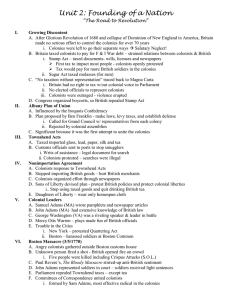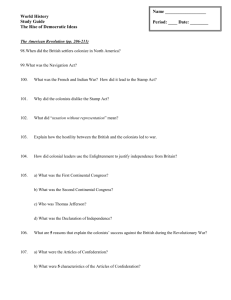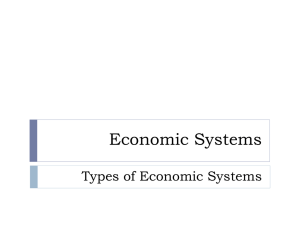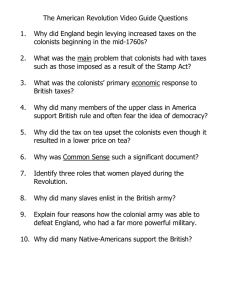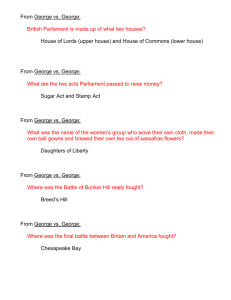Unit 2
advertisement
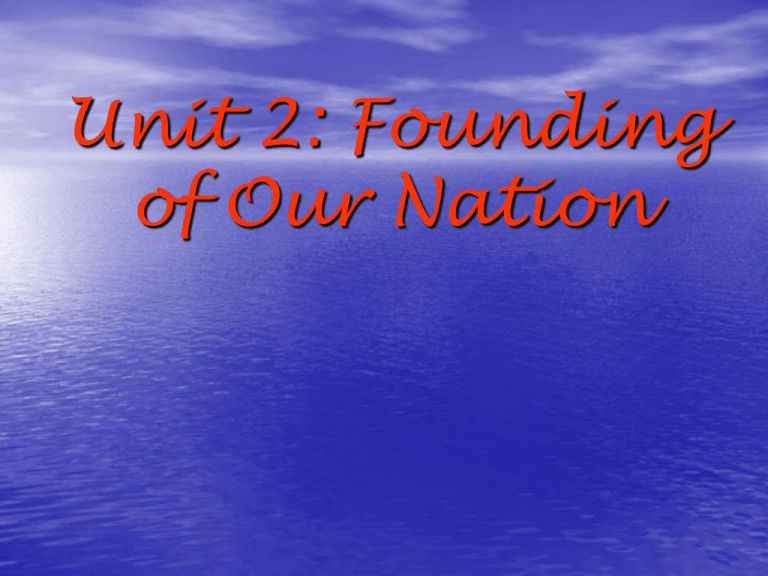
Unit 2: Founding of Our Nation The Road to Revolution 1. How did the end of the French and Indian War lead the American colonists on the road to revolution? 2. Describe the significance of the following taxes by the British Parliament. I. Growing Discontent • Britain made no serious effort to control the colonies for 70 years – • Britain taxed colonists to pay for French & Indian war debt; strained relations between colonists & British Stamp Act taxed documents such as wills, licenses and newspapers • – – • Colonies were left to go their separate ways Salutary Neglect! Significance: First tax to impact most people and colonists openly protested Tax would pay for more British soldiers in the colonies Sugar Act taxed molasses (for rum) “No Taxation without Representation” • Traced back to Magna Carta • Britain had no right to tax • • • w/out colonial voice in Parliament No elected officials to represent colonists Colonists were outraged & violence erupted Boycotts were organized, so British repealed Stamp Act Colonial Responses • Virginia Resolves • Stamp Act Congress • Sons of Liberty • Riots • Burned stamps • Tarred & feathered tax collectors • BOYCOTTS!!!! Albany Plan of Union • • Influenced by the Iroquois Confederacy Plan proposed by Ben Franklin - make laws, levy taxes, and establish defense – – • Called for Grand Council w/ representatives from each colony Rejected by colonial assemblies Significance: It was the first attempt to unite the colonies Townshend Acts • • Taxed imported glass, lead, paper, silk and tea Customs officials sent to ports to stop smugglers i. Writs of assistance were legal document for search ii. Colonists protested claiming searches were illegal Nonimportation Agreement • • • • Colonists response to Townshend Acts Stopped importing British goods to hurt British merchants wallets Colonists organized effort through newspapers Sons of Liberty devised plan to protest British policies and protect colonial liberties – • Stop using taxed goods and quit drinking British tea Daughters of Liberty vowed to wear only homespun cloth Colonial Leaders • Samuel Adams (MA) wrote • • • pamphlets and newspaper articles John Adams (MA) had extensive knowledge of British law George Washington (VA) was a riveting speaker & leader in battle Mercy Otis Warren’s plays made fun of British officials 3. Provide details about these events and describe the colonial reaction to the following British policies. VI. The Boston Massacre • Angry colonists gathered • outside Boston customs house Unknown person fired a shot - British opened fire on crowd – Five people were killed including Crispus Attucks (Sons of Liberty member) • Paul Revere’s, The Bloody Massacre stirred-up antiBritish sentiment Results • John Adams • • represented soldiers in court – soldiers received light sentences Parliament repealed Townshend taxes, except tea Committees of Correspondence united colonists – formed by Sam Adams, most effective radical in the colonies Trouble over Tea • British East India Tea Co. was in financial trouble Tea Act (1773) passed, so BEIT Co. could sell directly to consumers • – – Meant to lower the price of tea Colonists were outraged, boycott the “accursed stuff” Boston Tea Party • Colonists reaction to the Tea • • • Act Gov. Hutchinson (MA) demanded tea be unloaded from ships Colonists dressed as Natives and boarded the ship Threw 342 chests of tea into Boston Harbor Coercive/Intolerable Acts • King George III response to the BTP • Shut down the port of Boston • Town meetings only held once a • • • year British officials were to be tried in England, not Massachusetts Quartering Act passed – citizens must house soldiers People of Boston must be punished! • First Continental Congress formed in response to Intolerable Acts – – – – 12 colonies attended, not GA Called for boycott of British goods & stop exporting to England Urged colonies to form militias Agreed to re-convene the following Spring 4. Describe the significance of the following major events in the Revolutionary War. • • • • “The British are Coming” Gen. Gage’s scouts reported Concord, MA had an arsenal On 4/18/1775, Gage sent 700 troops to seize arms William Dawes and Paul Revere warned the colonists in advance Battle at Lexington – “The Shot Heard Around the World” – Capt. Parker led 70 minutemen, but British advanced “The British are Coming” (cont.) • Battle at Concord – – British returned to find 300 men waiting at bridge British retreated – 73 dead, 200 wounded • THE FIGHT FOR INDEPENDENCE BEGINS!!! The American Revolution Green Mountain Boys • Led by Ethan Allen (Vermont) Surprise attack on Fort Ticonderoga resulted in victory • – Controlled key route to Canada 5. Describe the significance of the following individuals in the Revolutionary War. Last Effort for Peace • Olive Branch Petition sent to King George III (England) declaring loyalty – • Asked king to repeal Intolerable Acts Continental Army formed and George Washington was appointed leader British Military • • Strengths - experienced troops, powerful navy, ships could move soldiers Weaknesses - 3,000 miles from home, risked attacks in countryside because they didn’t know the land Continental Army • • Strengths - defending homeland, many owned rifles and were good shots & brilliant leader, GW Weaknesses – untrained troops, few cannons and little gunpowder & no navy Bunker Hill • • • • First major battle Patriots led by William Prescott, William Howe led British attack British victorious, but costly (1,000 men dead or wounded) Proved Americans could fight bravely Don’t shoot until you see the whites of their eyes! Advance to Canada • Montgomery seized Montreal (Nov. 1775) Benedict Arnold led troops to Quebec • – – • Planned to join forces with Montgomery during horrible winter French Canadians refused to support Americans Quebec was attacked Montgomery killed and Arnold wounded – Americans withdrew > British controlled Canada Common Sense • • • • Pamphlet written by Thomas Paine in Jan. 1776 United colonists – stated America should be independent & free from the control of the British Structured it like a sermon & used Biblical references to make his case to the people Sold more than 500,000 copies in the first year Declaration of Independence • Stated that citizens should abolish the govt. if it abuses power & form a new one – – • Jefferson actually wrote it – • Influenced by John Locke – right to life, liberty & property John Adams, Ben Franklin, Thomas Jefferson, Robert Livingston, & Roger Sherman July 4, 1776 delegates accepted the document Three main parts - Basic Rights / British Wrongs / An Independent Nation The Declaration of Independence The Committee Thomas Jefferson John Adams Benjamin Franklin Robert Livingston Roger Sherman *Jefferson actually put his pen on the parchment Competition Within • Patriots - colonists who supported independence Loyalists - colonists who remained loyal to Britain • – – Wealthy merchants & former govt. officials Difficult life > some were tarred and feathered Campaign in New York • British were led by Gen. Howe - 1,400 American causalities Howe pursued Gen. Washington across the Hudson and Delaware Rivers Nathan Hale slipped behind British lines & returned w/ detailed battle plans • • – Caught and hanged as a traitor and spy Battle of Trenton • GW led a surprise attack – – • Crossed Delaware River on Christmas night 1776 Continental Army launched successful surprise attack Caught the Hessians recovering from heavy night of partying – Americans then took Princeton > NEW HOPE!!!!! Battle of Saratoga • • The Turning Point of the war SIGNIFICANCE: Convinced France to openly support the American cause – – – – • King Louis XVI declared France an ally to America French Navy supported America in war effort > HUGE!!! Provided military aid from France Ended British threat to New England Boosted American spirits The Battle of Saratoga October 7, 1777 Turning Point of the War British General John Burgoyne surrendered to American General Horatio Gates at Saratoga, New York France decided to help the Americans and provide naval support Valley Forge • Continental Army struggled for survival – brutal winter – • • Smallpox outbreak avoided by inoculating the troops Women offered much needed assistance GW skillfully avoided mutiny by the troops Winter 1777-1778 Valley Forge, Pennsylvania Location was close enough to apply pressure, but far enough away to avoid a sneak attack 2,000 huts built, miles of trenches dug Fortifications built 2,000 soldiers die 2/3 from disease: influenza, smallpox typhus, typhoid, and dysentery Help from Abroad • • • Lafayette – Frenchman brought 6,000 trained troops to America Galvez – Spaniard secretly supplied gunpowder, medicine &muskets Von Steuben – Prussian trained soldiers to march and use bayonets Baron Friedrich von Steuben trained the troops War in the South • • • • • Battle of Moore’s Creek Bridge (NC) King’s Mountain (SC) was captured & boosted Patriots morale Francis Marion, “Swamp Fox,” led attacks that kept the British off guard in SC Daniel Morgan led Virginia Riflemen to victory at Cowpens (SC) Nathaniel Greene used “hitand-run” tactics that wore down the British An American Traitor • Benedict Arnold was a respected leader & close friend of GW Commanded fort at West Point • – • • Offered West Point to British Message was intercepted & West Point was saved Arnold escaped and joined British Victory at Last!!! • Yorktown was the final battle – – – • • British, led by Cornwallis, camped near Chesapeake Bay GW knew area well and realized British could be trapped French support Naval fleet led by de Grasse Troops led by Rochambeau – – GW led troops south from NY Supplies to British were cut off > forced Gen. Cornwallis to surrender. Yorktown: The Final Battle Victory at Last Cont. • Treaty of Paris (1783) – U.S. recognized as independent nation – Borders: Atlantic Ocean to Mississippi River – Congress ratified April 15, 1783 • UNITED STATES BECAME AN INDEPENDENT NATION! Reasons for Declaring Independence Citizens wanted to limit the power of government • Lack of representation – “No taxation without representation” • Protect personal freedoms • Desired to be represented fairly and equally in the lawmaking process Ideation • Magna Carta • • English laws traced to Magna Carta, or “Great Charter” – Limit power of ruler – Representative govt. w/ Parliament in control – Greater rights for citizens Enlightenment influences English Bill of Rights protected rights – T. Paine – “the mind once enlightened…” – J. Locke – right to life, liberty, and property – Montesquieu – separate powers of govt. (3 branches) 6. Describe the impact of the following on the creation of the new national government. American Models • League of the Iroquois (Iroquois Confederacy) – • • • Influenced Preamble to Constitution and the idea of unity New England town meetings VA House of Burgesses – legislative govt. Mayflower Compact State Constitutions • Republic put people in power elected governors – • • Limit govt. control & separation of powers Bill of Rights – George Mason (VA) Suffrage – white males that paid taxes & were property owners 7. How effective was the Articles of Confederation in ruling the new nation? • Articles of Confederation Our first Constitution – November 15, 1777 Created a central govt. w/ limited powers • – – – – – “Loose alliance” of states Congress – make and pass laws 13 States – 1 vote per state States – enforce laws No President – weary of too much power Articles of Confederation Cont. • Ratification required formal approval of all 13 states – – – – Conflicts over western lands VA, NY – largest land claims MD – refused until they got their share NY ratified in 1780 & VA approved in 1781 • Finally ratified in March 178 Weaknesses of Articles of Confederation • • • • Congress couldn’t impose taxes was the greatest weakness All states had to agree to pass laws No executive branch to enforce the laws passed by Congress Labeled as “feeble and ineffectual” Western Lands • • Land of Ordinance of 1785 raised revenue by selling land – Sold in large plots – companies not farmers – System settled the NW Territory NW Ordinance established govt. for NW – no slaves – Finest achievement under Articles of Confederation – Five states formed – OH, IN, IL, MI, and WI The Northwest Ordinance Shay’s Rebellion • Economic depression led to uprising of farmers – Farmers: high taxes + debt led to many foreclosures Revolt shut down the courts in Massachusetts – • • No courts = no foreclosures 2,000 rebels participated the militia was sent in and squashed the rebellion Shay’s Rebellion Cont. • Impact ~ Articles of Confederation was too weak – not working • Congress couldn’t raise taxes • No branch to enforce laws • All states had to agree to pass • laws Couldn’t regulate trade • Push for Change – – Revisions to A of C – national conference held No NE states or NC, SC, GA ~ Only 5 states attended 8. Describe the plans and compromises of the Constitutional Convention. Constitutional Convention • Purpose was to revise the Articles of Confederation Philadelphia in 1787 – Independence Hall Preserve the Union!!! 12 states sent 55 delegates - RI refused to attend • • • • – College educated w/ political experience James Madison - “Father of the Constitution” Best prepared delegate – wanted to preserve states rights w/ a strong Union Kept detailed records in his daily diary • • – Absent – J. Adams, Jefferson, S. Adams, P. Henry •Varied experience 30 fought in revolution - 15 saw serious action 39 members of Continental Congress 8 served on state Const. Conventions 3 State Governors – 4 past Governors 8 Signers of the Declaration of Ind. 8 Judges More than half were lawyers ¼ owned large commercial farms or plantations 31 college graduates 2 college presidents 3 college professors 2 future US Presidents 1 future Vice President 17 future Senators 11 future Representatives All were known in their states and at least ¼ had national reputations Virginia Plan – Madison • Strong national govt. w/ 3 branches – – – • Legislative – passes laws Executive – carries out laws Judicial – interprets laws Two-House legislature – based on population – Favored large states, so small states opposed New Jersey Plan – William Paterson • • • • Small states response to VA Plan Three branches One-house legislature: one state = one vote Federal govt. powers: taxes & regulate commerce The Great Compromise – Roger Sherman • • • • • – Major disagreement between VA/NJ Plans centered on representation of the people in govt. Upper house – Senate gets two reps per state (NJ plan) Lower house – House of Reps. – based on population (VA) Created a bicameral Congress based on population and equal representation Three-Fifths Compromise Southerners wanted slaves counted Slaves were counted as 3/5 for purpose of representation in Congress 10. Compare the ideas held by the Federalist and the AntiFederalists. Opposing Views • • – Federalism – divide power between fed/state govt. Checks and Balances - limit the power of govt. • • • • – Each branch checks the other two branches Congress passes laws but Pres. can veto Judicial Branch determines if laws passed by Congress are Constitutional Federalists – supported the Constitution Anti-federalists opposed Constitution because it lacked a Bill of Rights Claimed that it didn’t protect our rights! 11. What were the Federalist papers? The Federalists Papers • • • Purpose was to rally support for ratification of the Constitution Written by Alexander Hamilton, James Madison and John Jay States wouldn’t be overpowered by fed. govt. Ratification of the Constitution • 9 of 13 states needed to ratify June 1788 – NH was 9th state to approve • – • NY, VA, NC, and RI ratify later Bill of Rights – the first 10 Amendments to the Constitution Ratification of the Constitution • • • • • • • • • • • • Amendments – 2/3 vote propose, ¾ vote ratify 1. Speech, religion & press 2. Bear Arms 3. Lodging Troops 4. Search and seizure 5. Rights of accused 6. Trial by jury 7. Jury in civil case 8. Bail & punishment 9. Power of people 10. Power of states Constitution has three parts: Preamble, Articles 1-7 and Amendments 1-27 > Greatest living document in history! Forging the New Republic Washington Becomes President • A. Unanimous choice: Moved to NY – temporary capital B. Felt the responsibility of the nation was on his shoulders • – • i. “…feelings of a culprit who is going to execution” C. Established precedents for future Presidents to follow 12. Describe the precedents (examples) set by George Washington. Washington’s Cabinet • • • • • Precedent established – surrounded himself w/ trusted advisors (Executive Cabinet) Secretary of State – Thomas Jefferson Secretary of War – Henry Knox Secretary of Treasury – Alexander Hamilton Attorney General – Edmund Randolph 13. Compare the two political parties of the first party system. First Political Parties in the U.S. Federalists Led by Alexander Hamilton Strong national govt. Supported manufacturing/industry Loose construction Favored national bank vs. Democratic Republicans Led by Thomas Jefferson Small national govt. (power w/ states) Supported agriculture Strict construction Opposed national bank *Political parties formed due to disagreements over the role of govt.* 14. Describe the economic policies of Alexander Hamilton. Hamilton’s Economic Plan • • • • A. An effective govt. needed an “enlightened ruling class” B. Govt. should assume all existing public debt from the war C. The country needed a national bank D. The nation’s economy should be based on industry and manufacturing Hamilton’s Economic Plan Cont. • E. Needed to create govt. revenue – Taxes! – – • i. Tariff – tax on imported goods ii. Excise “sin” tax – liquor, tobacco and luxuries Compromise reached – moved the capital to Philadelphia, then DC – Southerners then agreed to state debt bill National Bank Issue • A. Most controversial part of Hamilton’s plan B. Loose construction – loose interpretation of Constitution • – – i. Hamilton – “necessary and proper clause” ii. Supported national bank •C. Strict construction – strict interpretation of Constitution Jefferson – “limit the power of govt.” ii. Opposed national bank •i. •D. President Washington signed the Bank Bill in 1791 Whiskey Rebellion • • • • • . A. Farmers objected violently to excise tax B. Tax affected their pocketbooks - attacked tax collectors D. 2,000 rebels threatened Pittsburgh E. GW and Hamilton led 13,000 troops to squash rebellion F. Farmers scattered “without spilling a drop of blood” Remaining Neutral • A. Washington issued Neutrality Proclamation in 1793 – – • • i. U.S. would be friendly and impartial w/ France and Great Britain ii. GW opted to stay out of French Revolution B. Edmund Genet, French ambassador, openly defied Neutrality Proclamation C. Washington demanded France replace Genet Remaining Neutral • Diplomatic challenges – – – • Jay’s Treaty (1794) - Chief Justice John Jay negotiated w/ British – – • Jefferson resigned as Sec. Of State British seized American ships & sailors imprisoned Britain stirred up trouble in NW Territory w/ natives Brits paid for damages to ships & left forts in NW Territory No more impressments of sailors Pinckney’s Treaty- settled border and trade disputes w/ Spain Conflicts in the NW Territory (1790’s) • • • • A. Violence over land w/ Native Americans - Ohio and Indiana B. Little Turtle led forces to victory - greatest Native American victory over white man C. Battle of Fallen Timbers - Miami’s were defeated D. Treaty of Greenville (1795) gained OH, IN, IL and MI Farewell Address by Washington • A. Precedent established for our future leaders – – – – • i. Warned of dangers of political parties (divided country) ii. Avoid foreign entanglements – supported his policy of neutrality iii. Two-term limit for the President iv. Executive Cabinet B. Religious principle would guide national morality President Adams • A. Election of 1796: Adams (F) defeated Jefferson (D-R) 71 to 68 B. Flaw in the ConstitutionJefferson was VP, (Adams rival) C. XYZ Affair • • – – – – – – Jay’s Treaty didn’t sit well w/ France US diplomats were disrespected and French wanted bribes Adams went to Congress and named French agents X,Y and Z Americans wanted war Congress responded - cut-off trade w/ France, cancelled wartime treaties, built warships and captured French vessels US skillfully avoided costly war w/ France Alien and Sedition Acts • • • • • • Response to XYZ and resentment of foreigners Foreigners must register w/ govt. Allowed president to jail or deport “dangerous” foreigners Prohibited criticism of public officials (FREEDOM OF SPEECH?) Jefferson and Madison argued that acts were unconstitutional Created deeper divide in Congress and the country 15. Explain the contributions of John Marshall in the establishment of the Judicial Branch as an equal branch of government. Marbury vs. Madison • A. Supreme Court defined its power of judicial review by declaring an act of Congress unconstitutional B. John Marshall ~ “Father of the Supreme Court” • – – • Chief Justice from 1801 -1835 Established Supreme Court as coequal third branch of govt. C. Helped establish power of judicial branch w/ judicial review – Judicial review provides checks and balances w/ other two branches of govt.

